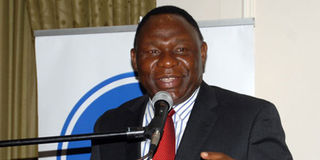NDEMO: A glimpse of India with a Kenyan familiarity

Bitange Ndemo
What you need to know:
- I got to know that until a few decades ago, India was a basket case relying on foreign powers to provide food.
- The big Airport in Delhi was built during the Commonwealth Games barely five years ago but maintenance, just like in Kenya, seems to be a challenge
- Three quarters of the vehicles you see are either a Maruti or a Mahindra. Indians are loyal to their brands
Hovering over Madhya Pradesh on my way into Delhi on a clear sunny day, I look below. The people here are poor but smart.
India is organised into villages and many years of land reforms has created expansive land for agricultural activity.
While reading excerpts on Indira Gandhi, I got to know that until a few decades ago, India was a basket case relying on foreign powers to provide food.
The drought of 1966 was the turning point. Indira then was critical to the Americans bombing Vietnam while the multilateral donors were putting conditions such as economic liberalisation in order to get food.
It is then that she decided to move on and ensure food security for her people.
A quick reference on Wikipedia reveals that Gandhi expanded the emphasis on production of inputs to agriculture that had already been initiated by her father, Jawaharlal Nehru.
The Green Revolution in India ended under her government in the 1970s and transformed the country from a nation heavily reliant on imported grains and prone to famine to being largely able to feed itself, and become successful in achieving its goal of food security.
Gandhi had a personal motive in pursuing agricultural self-sufficiency, having found India's dependency on the US for shipments of grains humiliating.
Behind my seat, I overhear a mesmerised man with a British accent ask his colleague, “Did you know that on September 12, 2013 the Indian National Food Security Bill, 2013 (also known as Right to Food Bill), was signed into law? This law aims to provide subsidised food grains to approximately two thirds of India's 1.2 billion people.”
Telepathically, we were on the same wavelength perhaps wondering how the country feeds itself. I say to myself; God help our country where Governors go to US to benchmark when the real thing is happening in India.
Bhatnager, who is seated next to me, tries to help me understand the Indian story. His eyes tell me that he is happy that I know a bit about his country and that I have some interest in their quest to succeed.
INDIAN LITERATURE
I ask him: "Is there one book I can read to get the understanding of India?"
He quickly responds, "no, no. This is a federal union with some states edging closer to communism and others moving forward with capitalism."
I tell him that I read Salman Rushdie’s Midnight’s Children. He becomes apprehensive as I try to reassure him that it isn’t about Islam as with The Satanic Verses. He blanks out.
"Can I tell you the story?" I ask. He looks across as if to reassure himself then he says, "yes yes."
Salman Rushdie wrote Midnight's Children in 1980 and basically, it deals with India's transition from British colonialism to independence and the partition of British India.
It is considered an example of postcolonial literature and magical realism.
The story is told by its chief protagonist, Saleem Sinai, and is set in the context of actual historical events as with historical fiction.
You see, he only courts controversy, Bhatnager seems to think. I tell him India was not an exception in postcolonial era and if you get to know what happened in most of the commonwealth countries, you will probably find you were better off.
If you want to know a people, then look into their literature and arts. Here in India, no one quite understands how back their literature dates. But Google has it and breaks it into two, that is, literature produced on the Indian subcontinent until 1947 (when India got its independence from Britain) and in the Republic of India.
Pre-independence literature was mostly in some 22 different Indian languages and as you may have guessed, post-independence literature was characterised by the new acquired language – English.
Just like Africa, ancient Indian literature was orally transmitted. Europeans estimate that the Sanskrit literature begins with the Rig Veda, a collection of sacred hymns dating to the period 1500–1200 BC.
The Sanskrit epics Ramayana and Mahabharata appeared towards the end of the first millennium BC. Just like Kenyans or Africans, the Indian scholars contest the dates but cannot quite give any logical dating thanks to our oral past.
INDISCIPLINE
As we land, I look outside. The tall grass is lush, green and uncut as if trying to tell you that the rains are here and we have no problem.
The plane taxies through the cargo handling area that is hugely unkempt. As I look up my Blackberry, I begin to internally debate within myself. If there are any similarities between India and Kenya, then it must be one thing – indiscipline.
The big Airport in Delhi was built during the Commonwealth Games barely five years ago but maintenance, just as in Kenya, seems to be a challenge. As I walk into the inside of the airport, it is clean. Did I talk too soon?
I bid farewell to Bhatnager at the Immigration area. Organisers of the conference had sent an e-mail to me that someone will pick me up.
Outside there was nobody with my name. As I walked around, I could feel the piercing eyes of people perhaps wondering why this African is here.
Eventually, one gentleman tells me to check towards outside. And for sure as I walk outside, there was a man with my name. I walk towards him and he asked, “are you the one?”
"Yes," I said.
"Let us go." He said without an apology. He had been idling with friends outside.
Three quarters of the vehicles you see are either a Maruti or a Mahindra. Indians are loyal to their brands. They are so small that three people like me plus luggage cannot fit into any one of them.
I ask my driver. "What is your name?"
"Sanjay." He says. He is quiet and quite introverted.
We get into a new Maruti. I nostalgically roll down the window. It is long time since I did that given that most vehicles’ windows are electronically controlled, which is both expensive and an unnecessary cost.
DRIVING IS A MESS
Although some of the roads are wide and great, driving is a mess.
One of their traffic rules may probably be that you drive where there is space as you fight tuk tuks, motorbikes, bicycles, tri-cycles and at some points beggars on the road. No one is worried about the traffic jam.
Yes, there are potholes and repairs to potholes may be even worse since in most cases it is not level and creates haphazard bumps.
Most of the houses have a distinctive Indian architecture, with flat roofs and gives you a Parklandish feel. If you are lucky as I was, you may spot English Manor house and some Gothic architecture.
We reach the expansive Grand Hotel, Delhi. The driver's eyes cannot hide his relief after dropping his luggage. I reach into my pocket and give to him 50 rupees.
To my surprise, Sanjay smiles for the first time and pulls his business card. He mumbles, "You want to see old Delhi, call me."
We part company as I walk into the hotel.
---
TO BE CONTINUED





